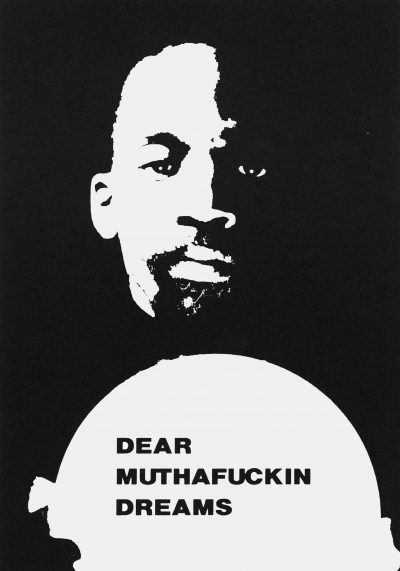
Photo: Daniel Cima
Dear Muthafuckin Dreams (1988)
Essex Hemphill confronts the politics of speech, language, and sexuality in Dear Muthafuckin Dreams (1988). Through a gay black lens, Hemphill addresses the cultural myth of the American Dream—the idea that every United States citizen has an equal opportunity to achieve success through hard work, initiative, and determination. Hemphill, along with Terence Johnson and Christopher Prince, employs the black tradition of call and response, while also utilizing vocal techniques of unison and counterpoint The performers interweave their vocal harmonies with an eclectic soundscape composed by Wayson Jones. These sonic elements are juxtaposed with visuals by Sharon Farmer, Ron Simmons, and Joyce Wellman. Dear Muthafuckin Dreams comments on the unfulfilled promises of the 1960s–1970s political era to fundamentally provide social equity to Black Americans.
ESSEX HEMPHILL (1957–1995) addressed issues central to the African American gay community through his poetry. His first collections of poems were the self-published chapbooks Earth Life (1985) and Conditions (1986). Hemphill’s Ceremonies: Prose and Poetry (1992) won the National Library Association’s Gay, Lesbian, and Bisexual New Author Award. His writing is included in the anthologies Gay and Lesbian Poetry in Our Time (1986) and Life Sentences: Writers, Artists, and AIDS (1993). Hemphill edited the anthology Brother to Brother: New Writing by Black Gay Men (1991), which won the Lambda Literary Award. He participated in the performance poetry group Cinque with Larry Duckette and Wayson Jones. The group’s work was later featured in the documentaries Tongues Untied (1989) and Black Is… Black Ain’t (1994). Hemphill’s poetry was also included in the film Looking for Langston (1989). He received fellowships and grants from the National Endowment for the Arts, Pew Charitable Trust Fellowship in the Arts, and the DC Commission on the Arts and Humanities. Hemphill was a visiting scholar at the Getty Center for the History of Art and the Humanities. He died of complications from AIDS in 1995.
WAYSON JONES is an interdisciplinary artist working in music, dance, spoken word, and painting. He performed with the renowned poet Essex Hemphill at the Kennedy Center Terrace Theater, La MaMa E.T.C., Painted Bride Art Center, and Blues Alley, among other venues. Jones has exhibited his art at the BlackRock Center for the Arts, Hillyer Art Space, District of Columbia Arts Center, Gallery O on H, Arts Harmony Hall, The David Driskell Center, Smith Center for Healing and the Arts, The Soundry, Candy Factory Center for the Arts, University of Mary Washington, Gallery 25, and Jeffrey Leder Gallery. His work has been purchased by the DC Commission on the Arts and Humanities, and can be found in private and corporate collections around the United States. Jones holds a degree in Music from the University of Maryland. www.waysonjones.com